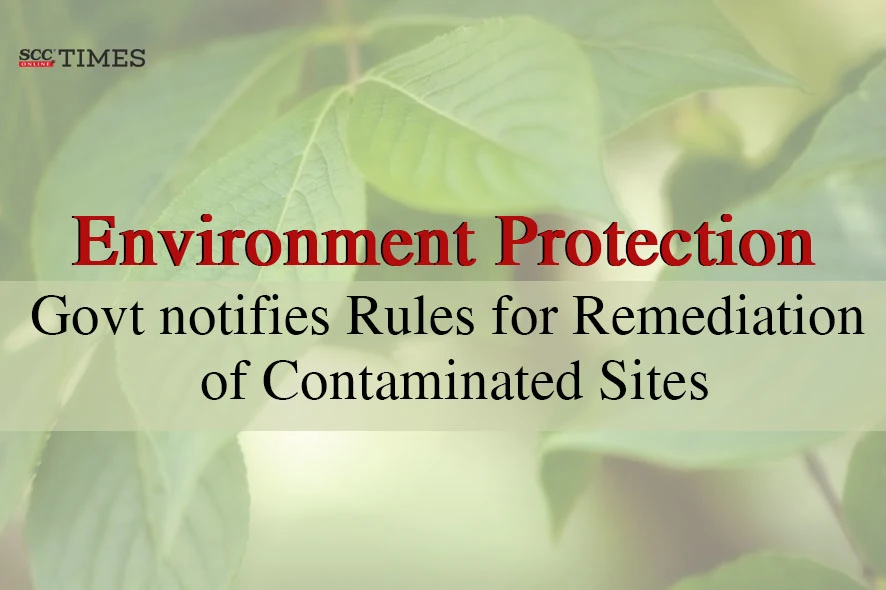On 24-7-2025, the Ministry of Environment, Forest and Climate Change notified the Environment Protection (Management of Contaminated Sites) Rules, 2025 to address the growing concern of environmental contamination and its impact on human health.
The provisions came into force on 24-7-2025.
Applicable on:
- ‘Radioactive waste’ as defined under the Atomic Energy (Safe Disposal of Radioactive Wastes) Rules, 1987;
- ‘Mining operations’ as defined under the Mines and Minerals (Development and Regulation) Act, 1957;
- Pollution of the sea by oil or oily substance as governed by Merchant Shipping Act of 1958 and the Merchant Shipping (Prevention of Pollution of the Sea by Oil) Rules, 1974;
- ‘Solid waste dump’ as defined under Solid Waste Management Rules, 2016.
- In case contamination of a site is due to a contaminant mixed with radioactive waste/ mining operations/ oil spill/ solid waste from dump site, and if the contamination of the site due to the contaminant exceeds the limit of response level specified in these rules, then remediation of the site would be covered under these rules.
Key Points:
-
Identification of contaminated sites:
- The local body or District Administration will be responsible for identifying an area affected with contaminants, on its own or on receipt of a complaint from public, and list areas as suspected contamination sites in its jurisdiction on centralized online portal.
- The local body or District Administration will have to furnish the list of suspected contaminated sites to the State Board periodically on a half yearly basis on the centralized online portal.
- The State Board will identify suspected contaminated sites located in the industries/ industrial premises through the Consent Monitoring Mechanism.
- The State Board will undertake preliminary site assessment of the suspected contaminated site by sampling and analysis, within 90 days from the date of receipt of list.
- On completion of the preliminary site assessment, the State Board may list the suspected contaminated site as probable contaminated site if the contaminant is found to be above the screening level or delist the site as investigated site if the contaminant is found to be below the screening level.
- The State Board will furnish such list of probable contaminated sites and investigated sites to the CPCB on the centralized online portal, within 30 days from the date of completion of the preliminary site assessment.
- The State Board will undertake a detailed site assessment of a probable contaminated site by detailed sampling and analysis covering the entire geographical area of the probable contaminated site, within 3 months from the date of listing of such site.
- After completion of the detailed site assessment, the State Board can list the site as a contaminated site for further action if the contaminant is found to be above the response level.
- The State Board, after completion of the detailed site assessment, may delist the site as investigated if contaminant is found to be below response level.
- The State Board will have to select a reference organization within 3 months from the date of publication of a list of the contamination sites and initiate preparation of remediation plan and execute remediation activities.
- The State Board will have to identify the person responsible for causing the contamination of the site within 90 days.
- Handling and management of contaminants during assessment and remediation will be carried out in accordance with the Standard Operating Procedure issued by the Central Pollution Control Board (‘CPCB’).
- After completing remediation, the State Board will submit its report to the CPCB, and the CPCB will appoint any reference organization to verify completion of remediation activities.
-
Reference organization:
- The organization wanting to become a reference organization will have to make an application to the CPCB.
- The CPCB will evaluate the credentials and communicate regarding the empanelment of reference organization or reject the application with reasons, within 60 days.
- The CPCB shall publish the list of empaneled reference organizations on its website and update the list on a quarterly basis.
-
Centralized Online Portal:
- CPCB will develop the centralized online portal for the purpose of reporting of suspected contaminated sites, probable contaminated sites and contaminated sites, and monitoring of assessment of contamination and remediation of contaminated sites under these rules.
- State Board will update all its activities including listing of probable contaminated sites and contaminated sites and its geotagging or geo-fencing, remote sensing and satellite imagery; status of preparation of the remediation plan; remediation activities; the list of responsible persons; uploading Remediation Completion Order and post remediation monitoring activities; on the centralized online portal.
-
Environmental Compensation:
- State Government can impose environmental compensation on any responsible person who does not comply with the provisions of these rules in undertaking the remediation or does not undertake the remediation under these rules in respect of a contaminated site and poses risks to human life and the environment contributing thereby to loss, damage or injury to environment or human health.
- In case the State Board fails to impose environmental compensation in 60 days, the CPCB can impose the same.
- The payment of environmental compensation shall not absolve the responsible persons from payment of remediation cost that has been levied.



